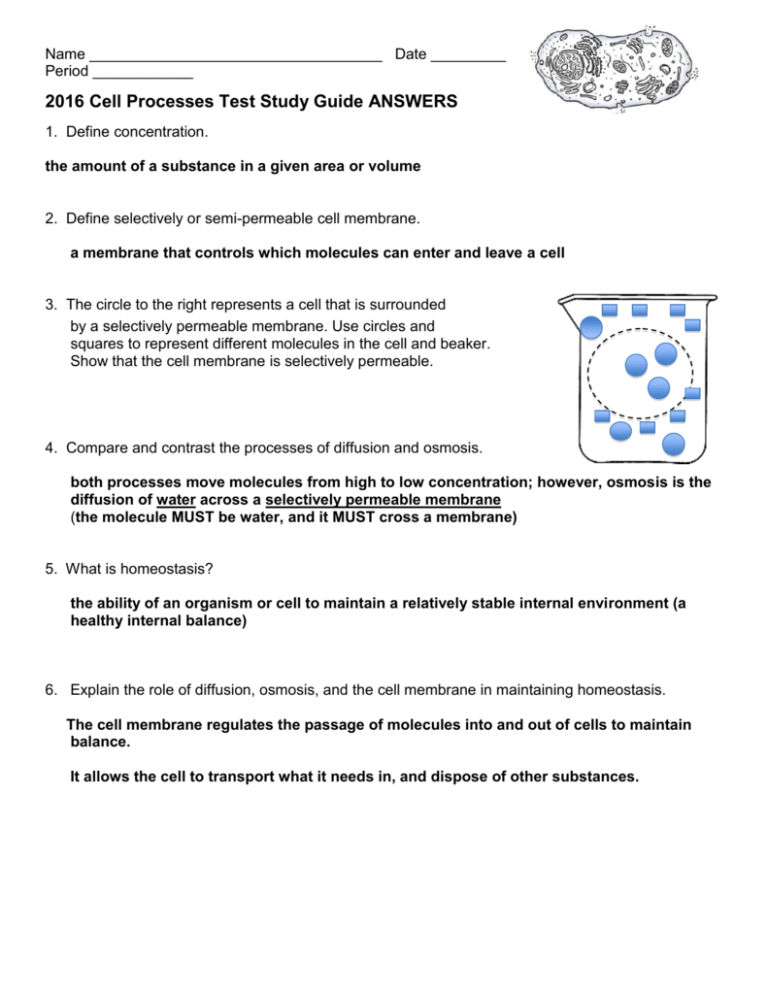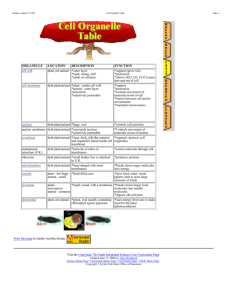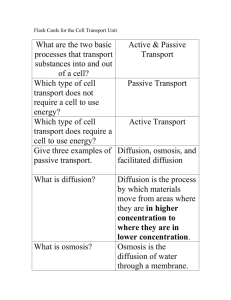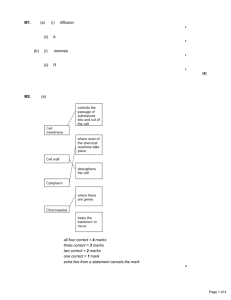Cell Test # 2 Study Guide with answers
advertisement

Name ___________________________________ Date _________ Period ____________ 2016 Cell Processes Test Study Guide ANSWERS 1. Define concentration. the amount of a substance in a given area or volume 2. Define selectively or semi-permeable cell membrane. a membrane that controls which molecules can enter and leave a cell 3. The circle to the right represents a cell that is surrounded by a selectively permeable membrane. Use circles and squares to represent different molecules in the cell and beaker. Show that the cell membrane is selectively permeable. 4. Compare and contrast the processes of diffusion and osmosis. both processes move molecules from high to low concentration; however, osmosis is the diffusion of water across a selectively permeable membrane (the molecule MUST be water, and it MUST cross a membrane) 5. What is homeostasis? the ability of an organism or cell to maintain a relatively stable internal environment (a healthy internal balance) 6. Explain the role of diffusion, osmosis, and the cell membrane in maintaining homeostasis. The cell membrane regulates the passage of molecules into and out of cells to maintain balance. It allows the cell to transport what it needs in, and dispose of other substances. 7. Explain what is happening in the diagram below. What is the name of this process? P passive transport – molecules move from high to low concentration to achieve an equal concentration * DIFFUSION * 8. Red Onion Lab Draw an onion cell in tap and salt water. Indicate high and low concentrations of water. Include arrows showing movement of the water molecules. *name the process ___osmosis_________ tap water red onion cell in tap water – water molecules enter and exit the cell at an equal rate by the process of osmosis; the cytoplasm is full (water moves from high to low concentration) saltwater red onion cell in saltwater – water molecules exit the cell by the process of osmosis; the cytoplasm of the cell decreases in size (water moves from high to low concentration) name the process illustrated above _____osmosis________________________________ Which part(s) of the cell is (are) affected by exposure to different salinities? _____cytoplasm and vacuoles__________________________________________________ 9. What evidence do we have to demonstrate that the red onion cell’s membrane is selectively permeable? As water entered and exited the cell, the color of the cytoplasm lightened and darkened respectively, but the pigment itself never left the cell. 10. Use arrows to indicate the direction of molecular movement. can pass through the cell membrane . A) is a molecule that B) out of the cell into the cell 11. What would the process be called if the molecule in question #10 was oxygen? diffusion 12. What would the process be called if the molecule in question #10 was water? osmosis 13. Summarize what you learned from the Egg Lab, Red Onion Lab, and Potato Osmosis Lab. molecular movement from high to low molecules enter and exit selectively permeable cell membranes osmosis = water + membrane; other molecules crossing membrane = diffusion cytoplasm and vacuoles are affected cell structures size (length & mass) affected by molecular transport









